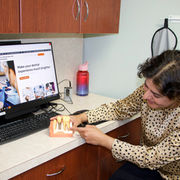Dental Plaque: What Is It & How To Remove From Teeth
- Dr. Michael Ofir

- Nov 20, 2023
- 3 min read
Dental plaque is a sticky, colorless, or pale-yellow film constantly forming on your teeth and along the gumline. It develops naturally in the mouth and accumulates shortly after eating and drinking. When saliva, food, and fluids combine, plaque - which contains bacteria - forms between your teeth and along the gum line. Dental plaque begins forming on teeth 4-12 hours after brushing, which is why brushing thoroughly at least twice a day and flossing daily is so important. If not carefully removed by daily brushing and flossing, plaque hardens into a rough, porous substance known as calculus (or tartar). It can lead to various dental issues and pose significant dangers to oral health. Tartar can only be removed by a dental professional. You can remove these germs and help prevent periodontal disease by thorough daily brushing and flossing.
Adults over 35 lose more teeth to gum diseases (periodontal disease) than cavities. Three out of four adults are affected at some time in their life. The best way to prevent cavities and periodontal disease is by good tooth brushing and flossing techniques performed daily. Periodontal disease and decay are both caused by bacteria found in dental plaque. Did you know that dental plaque is a bustling community of over 300 different bacteria? Keeping this microbial metropolis in check is crucial for a healthy smile! Stay diligent with your oral care routine and bid farewell to plaque buildup!

Plaque contains bacteria that feed on sugars and carbohydrates from our foods. As these bacteria break down these sugars, they produce acids that attack the tooth enamel. Over time, these acid attacks can weaken the enamel and lead to cavities (tooth decay). As plaque accumulates along the gumline, it can irritate the gum tissue, leading to inflammation and swelling. Plaque and tartar buildup near the gumline can lead to exposure of the tooth roots, causing tooth sensitivity to hot or cold temperatures. Plaque can cause surface stains on teeth, making them appear yellow or discolored. For people undergoing orthodontic treatment, plaque can accumulate around brackets and wires, increasing the risk of cavities and gum problems.
Poor oral hygiene and the presence of plaque have been linked to various systemic health issues, including cardiovascular disease, diabetes, respiratory problems, and adverse pregnancy outcomes. Preventing and removing dental plaque is essential for maintaining optimal oral health. Regular brushing, flossing, and routine dental check-ups are necessary to keep plaque under control. Additionally, a balanced diet low in sugary and starchy foods can help minimize plaque formation. By effectively managing plaque, you can reduce the risk of dental issues and maintain a healthy smile.
When plaque is not adequately removed through regular oral hygiene practices such as brushing and flossing, it can mineralize and harden over time, forming dental calculus. Dental calculus, commonly known as tartar, is a hard, yellowish, or brownish deposit that forms on the teeth due to the accumulation of dental plaque. This is a bio formation that we do not want to see on our teeth or on that of others. You need to know that once formed, it can be removed only by a dentist. Since dental plaque harms your teeth, it is recommended that you take good care of your oral health and do a regular check-up to help clean any food debris on your teeth to prevent any plaque build-ups.
For more information about dental health and cleanings, please call one of our offices or contact us online.

















Comments